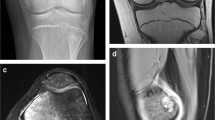Abstract
Objectives
The objectives of this communication were to discuss radiographic and magnetic resonance (MR) imaging manifestations and clinical outcome after complete and incomplete resection of the mass of dysplasia epiphysealis hemimelica (DEH).
Materials and methods
Clinical records, radiographs, and MR images of eight patients with DEH were retrospectively examined. Six patients were treated by complete excision of the lesional mass, and two patients were treated by incomplete resection at our University Hospitals during the period from 1980 to 2006.
Results
We found that, unlike in osteochondroma, DEH was radiographically not clearly separable from the underlying or host bone with preserved cortical bone and marrow continuity. The finding in the talus distinguished DEH from (osteochondroma-like) parosteal osteosarcoma, in which a radiolucent demarcation line clearly separated the tumor from the host bone. The DEH mass had a well-defined low to intermediate signal intensity on T1-weighted images and an intermediate to high signal intensity on T2-weighted images, with irregularity of the articular surface. Simple excision was performed in all patients. The excision was complete in six patients and incomplete in two patients whose lesions was juxta-articular in the ankle and articular in the knee, respectively. The residual mass slowly absorbed and vanished, resulting in mild flaring of the affected portion of the epiphysis. No local recurrence or complication was seen in any of the eight patients.
Conclusions
Although the radiographic signs of DEH are characteristic, (osteochondroma-like) parosteal osteosarcoma should be differentiated from DEH when there is a radiolucent separation line between the mass and host bone in the talus. Simple excision was effective in the management of DEH if the deformity was not complicated. Incompletely excised masses resolved and vanished with time.






Similar content being viewed by others
References
Fairbank TJ. Dysplasia epiphysealis hemimelica (tarso-epiphysealis aclasis). J Bone Joint Surg Br. 1956;38:237–57.
Trevor D. Tarso-epiphysealis aclasis: a congenital error of epiphysealis development. J Bone Joint Surg Br. 1950;32:204–13.
Azouz EM, Slomic AM, Marton D, Rigault P, Finidori G. The variable manifestations of dysplasia epiphysealis hemimelica. Pediatr Radiol. 1985;15:44–9.
Conner JM, Horan FT, Beighton P. Dysplasia epiphysealis hemimelica. A clinical and genetic study. J Bone Joint Surg Br. 1983;65:350–4.
Keret D, Spatz DK, Caro PA, Mason DE. Dysplasia epiphysealis hemimelica: diagnosis and treatment. J Pediatr Orthop. 1992;12:365–72.
Kettelkamp DB, Campbell CJ, Bonfiglio M. Dysplasia epiphysealis hemimelica. A report of fifteen cases and a review of the literature. J Bone Joint Surg Am. 1966;48:746–66.
Kuo RS, Bellemore MC, Monsell FP, Frawley K, Kozlowski K. Dysplasia epiphysealis hemimelica. Clinical features and management. J Pediatr Orthop. 1998;18:43–8.
Rosero VM, Kiss S, Trebessy T, Köllö K, Szöke G. Dysplasia epiphysealis hemimelica (Trevor’s disease): 7 of our own cases and a review of the literature. Acta Orthop. 2007;78:856–61.
Murphy DM, Choi JJ, Krandorf MJ, Flemming DJ, Gannon FH. Imaging of osteochondroma: variants and complications with radiologic-pathologic correlation. Radiographics. 2000;20:1407–34.
Lin J, Yao L, Mirra JM, Bahk WJ. Osteochondromalike parosteal osteosarcoma: a report of six cases of new entity. AJR Am J Roentgenol. 1998;170:1571–7.
Noyes FR, Kivi LP. Dysplasia epiphysealis hemimelica. A case simulating an intra-articular body. Clin Orthop. 1972;82:175–7.
Lang IM, Azouz EM. MRI appearances of dysplasia epiphysealis hemimelica of the knee. Skeletal Radiol. 1997;26:226–9.
Farr GH, Huvos AG. Juxtacortical osteogenic sarcoma. An analysis of fourteen cases. J Bone Joint Surg Am. 1972;54:1205–16.
Jee WH, Chloe BY, Ok IY, Kim JM, Choi YI, Choi KH, et al. Recurrent parosteal osteosarcoma of the talus in a 2-year-old child. Skeletal Radiol. 1998;27:157–60.
Iwasawa T, Aida N, Kobayashi N, Nishimura G. MRI findings of dysplasia epiphysealis hemimelica. Pediatr Radiol. 1996;26:65–7.
Author information
Authors and Affiliations
Corresponding author
Rights and permissions
About this article
Cite this article
Bahk, WJ., Lee, HY., Kang, YK. et al. Dysplasia epiphysealis hemimelica: radiographic and magnetic resonance imaging features and clinical outcome of complete and incomplete resection. Skeletal Radiol 39, 85–90 (2010). https://doi.org/10.1007/s00256-009-0803-x
Received:
Revised:
Accepted:
Published:
Issue Date:
DOI: https://doi.org/10.1007/s00256-009-0803-x




